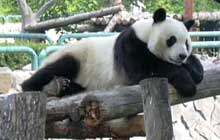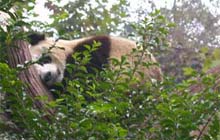
TRAVEL EDITOR'S NOTE: Sue Naessens (a former guest of Imperial Tours) is on the staff at Redeemer Lutheran Church. Her husband, Jim, works in health care policy and research at the Mayo Clinic
 China boasts many treasures with its long history and rich cultural heritage. The Great Wall, theTerracotta Warriors and Forbidden City readily come to mind. Museums overflow with art of every genre. Silk embroidery is nationally famous. Classical gardens, spectacular scenery, delicious food…. what more could one wish for?
China boasts many treasures with its long history and rich cultural heritage. The Great Wall, theTerracotta Warriors and Forbidden City readily come to mind. Museums overflow with art of every genre. Silk embroidery is nationally famous. Classical gardens, spectacular scenery, delicious food…. what more could one wish for?
Pandas!
Pandas are truly a national treasure of China, especially as they are an endangered species. My husband Jim and I love animals, so when we began planning our trip, seeing pandas was a high priority. Discovering however that most package tours rarely include even a visit to a zoo, we began investigating independent travel.
Margot Kong of Imperial Tours ( www.imperialtours.net ) helped us put together the trip of a lifetime by tailoring an itinerary to our interests. We enjoyed a cruise on the Yangtze and visited seven cities, one of which was Chengdu, capital of Sichuan province, home to the giantpanda.
Just north of Chengdu, we visited the Giant Panda Breeding Research Base. It covers 600 acres and supports a team of 48 scientists and technicians who conduct research on reproduction, genetics and endocrinology, disease control, behavior and nutrition. They maintain a captive population of about 40 pandas and release their offspring into the wild at an appropriate time. They also educate the public on conservation issues and provide leadership to facilitate scientific conferences. Researchers from Britain, the United States and Japan have conducted studies there.
What a wonderful facility. In a beautiful, park-like setting we observed pandas at play, climbing trees and eating bamboo. We visited the nursery and saw three infants less than a month old kept in incubators. A newborn cub is roughly the size of a gopher with delicate white fuzzz covering pink skin. By three weeks, it will have grown to the size of a small guinea pig and will have begun acquiring the black and white markings so distinctive to the species.
 During a video presentation, we watched a panda giving birth at the research base. It happened very quickly; the baby simply popped out and it had about as much effect on the mother as if she were blowing her nose! (I was envious!) A first time mother, the female didn't fully grasp what had happened. We held our breath as she began batting her newborn around the cell as if it were a plaything. The infant was quickly rescued by research staff and gradually re-introduced to its mother. Once she caught on, the female was very nurturing. A new mother will usually hold her baby continually for several weeks. Sometimes she may play with the cub by rolling it around or tossing it back and forth between her paws.
During a video presentation, we watched a panda giving birth at the research base. It happened very quickly; the baby simply popped out and it had about as much effect on the mother as if she were blowing her nose! (I was envious!) A first time mother, the female didn't fully grasp what had happened. We held our breath as she began batting her newborn around the cell as if it were a plaything. The infant was quickly rescued by research staff and gradually re-introduced to its mother. Once she caught on, the female was very nurturing. A new mother will usually hold her baby continually for several weeks. Sometimes she may play with the cub by rolling it around or tossing it back and forth between her paws.
Typically, pandas live about 20 years, subsisting on a diet primarily of bamboo. Cubs will stay with their mothers for 18 months. They mature at 5 years and may begin to mate. Pandas have an extremely limited breeding season, approximately one to three days per year. This contributes to the endangering of the species along with poaching and destruction of natural habitats. Sometimes pandas get tangled in traps intended for other animals, causing injury and making them more vulnerable to natural predators.
Red pandas, or "lesser pandas", are also studied at the base. Much smaller than the giant panda, they resemble raccoons. They live about 17 years in captivitiy and eat, not only bamboo, but also grasses, roots and berries, and sometimes even young birds or small rodents.
Our visit culminated with the opportunity to hold and play with Yaxing (pronounced "ya-shing"), a 1-year-old, 40-pound female cub! We had to put on a special gown and gloves, not for our benefit, but to protect the bear.
Yaxing was very friendly and playful. She acted like a puppy, batting and nipping at our hands. Of all the highlights we experienced on the tour, this was certainly the most endearing.
Although our time in Chengdu represents only a small segment of our trip, the memories incurred there are anything but small. Pandas indeed are to be counted among the treasures of China.